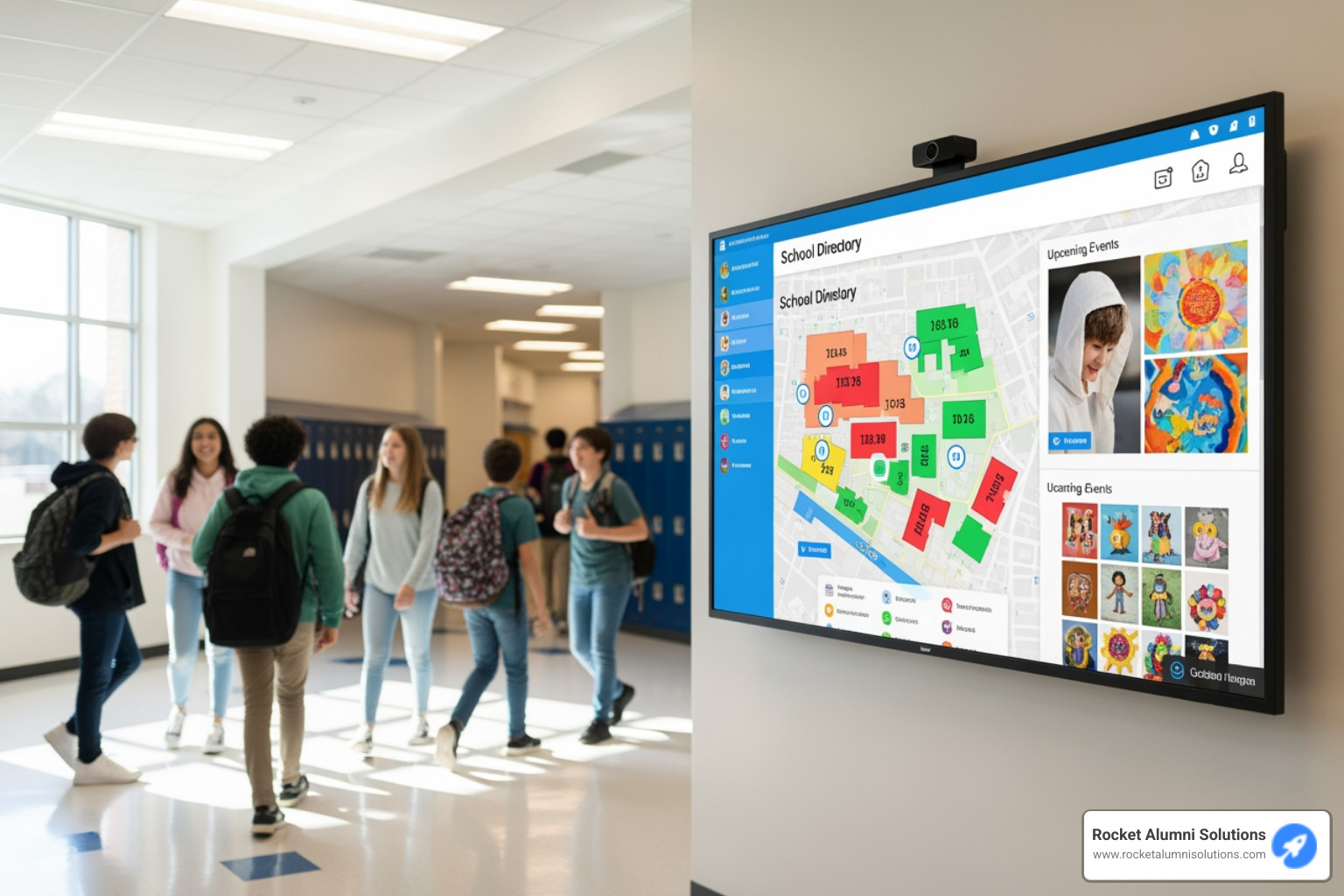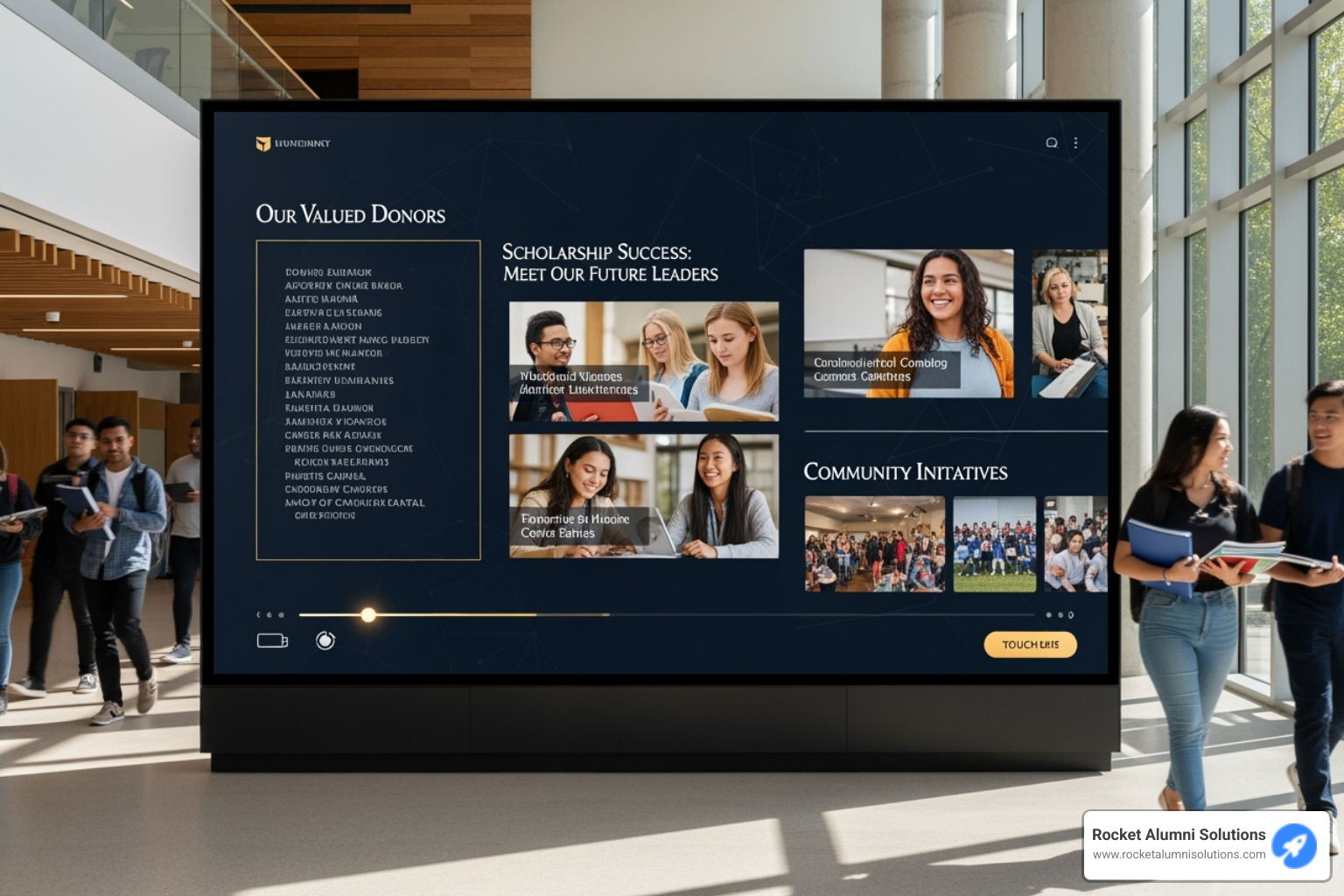Why Nursing Home Touchscreen Technology is Changing Senior Care
Nursing Home Touchscreen technology is revolutionizing how care facilities engage residents, streamline operations, and improve quality of life. These interactive displays range from personal tablets to large community tables, offering everything from cognitive games and video calls to staff management tools and visitor check-ins.
Key Applications of Nursing Home Touchscreens:
- Resident Engagement: Interactive games, virtual travel, reminiscence therapy
- Communication: Video calls with family, social media access, email
- Physical Activity: Guided exercises, virtual bike rides, dexterity training
- Staff Operations: Patient documentation, visitor management, health screening
- Entertainment: Music, classic films, puzzles, trivia games
- Cognitive Support: Memory games, brain training apps, personalized content
The impact is measurable. Research shows that group activity attendance in skilled nursing centers increased from 10-12 people to 30-35 people after implementing touchscreen technology. Another study found that participants attended an impressive 80% of digital reminiscence therapy sessions, demonstrating strong engagement levels.
"It's absolutely amazing!" says Maggie Rushing, an Activities Director who witnessed how touchscreen systems transformed resident participation. The technology addresses critical challenges in senior care - from social isolation to cognitive decline - while making daily operations more efficient for staff.
As Chase McKee RAS, founder of Rocket Alumni Solutions, I've seen how interactive touchscreen displays can transform community engagement across various sectors, including healthcare environments where nursing home touchscreen applications create meaningful connections between residents, families, and staff. My experience building touchscreen solutions has shown me that the right technology can dramatically improve quality of life while streamlining operations.
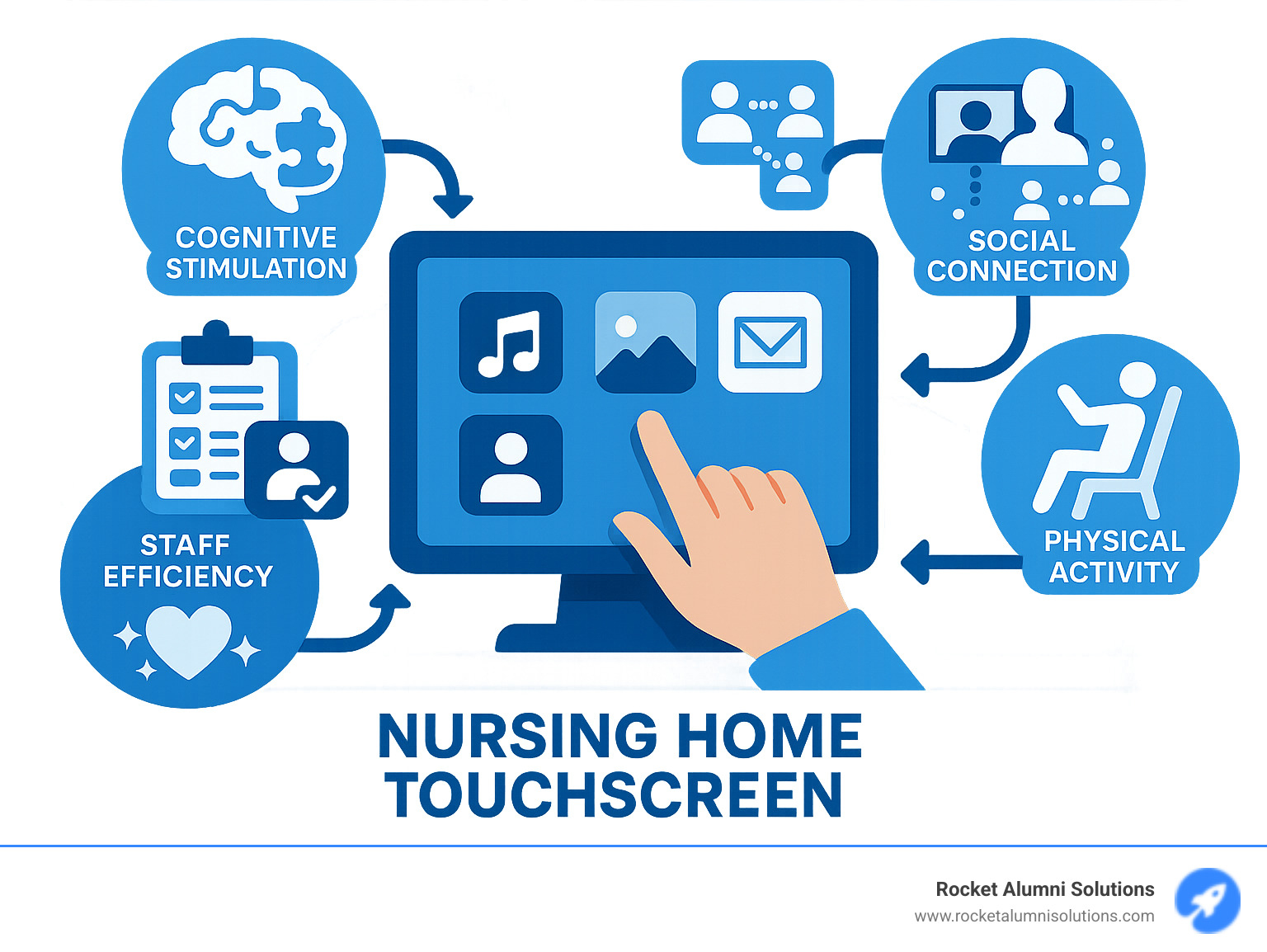
Nursing Home Touchscreen terms at a glance:
The Spectrum of Touchscreen Technology in Modern Care Facilities
When we talk about nursing home touchscreen technology, we're looking at a whole family of devices that can transform how care facilities operate. It's not just about one type of screen - there's actually an incredible variety of interactive displays designed specifically for senior care environments.
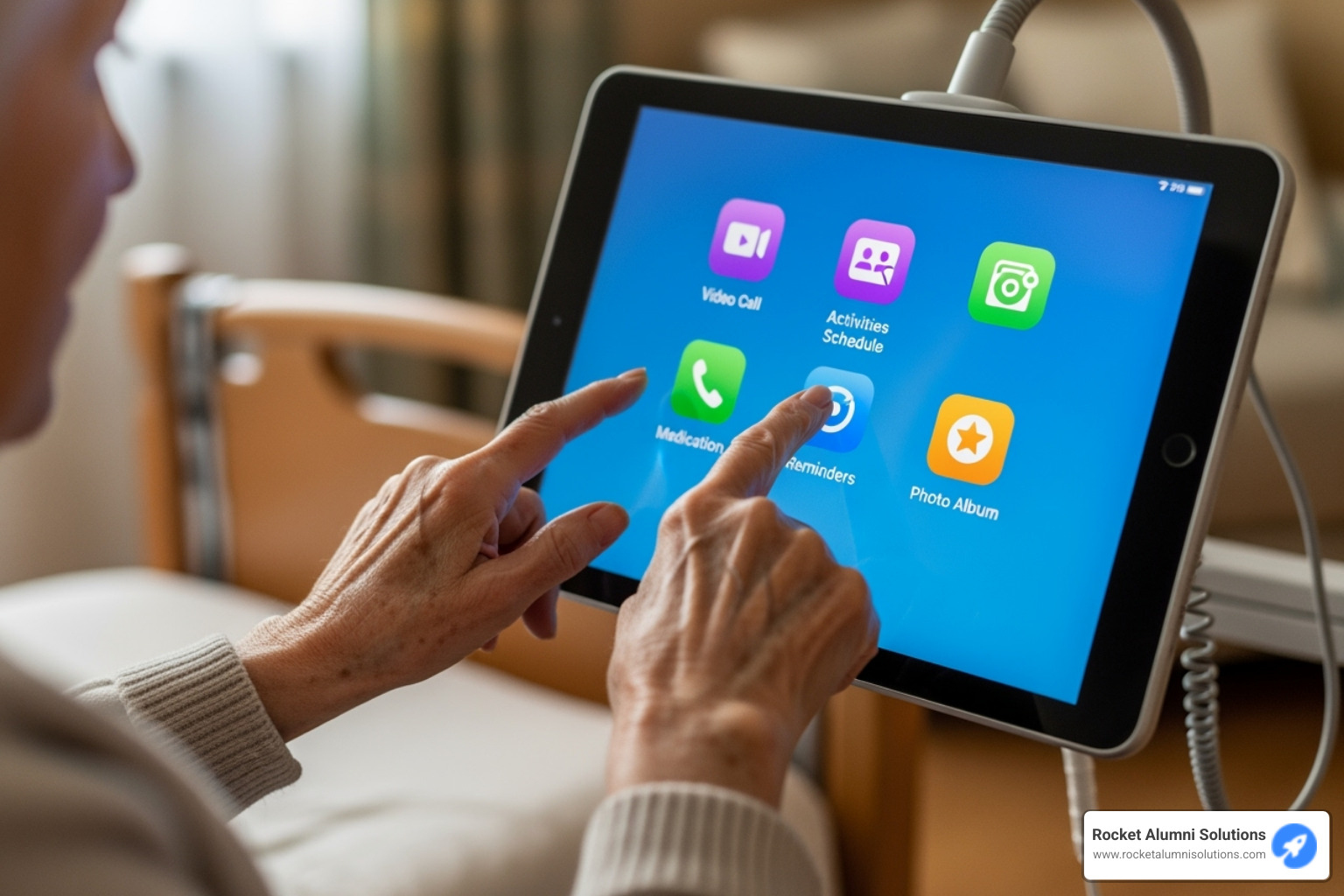
Think of it like choosing the right tool for the job. Interactive tables bring people together for group activities, while mobile tablets offer personal, one-on-one experiences. Wall-mounted digital displays keep everyone informed about daily activities, and freestanding kiosks handle visitor check-ins smoothly. Some facilities even use projection-based systems that turn floors and walls into interactive surfaces - pretty amazing when you see it in action!
What makes these systems special for healthcare settings is their medical-grade hardware. They're built tough, easy to clean, and designed to work reliably day after day. Many also include ADA-compliant features, making them accessible for residents with different physical abilities. If you're wondering which system might work best for your facility, our Essential Touchscreen Kiosk Guide breaks down the key considerations.
Interactive Touchscreen Tables
Interactive touchscreen tables are often the star of any nursing home common room. These large, sturdy surfaces become gathering spots where residents naturally come together for games, activities, and conversations. What's wonderful about these tables is how they support multiple people using them at once - no waiting for turns or fighting over controls.
The thoughtful design really shines through in the details. Many tables adjust in height and tilt to accommodate wheelchairs or residents who prefer to lean in from their chairs. Some models run on batteries, which means activities don't have to stay in one room. Staff can roll the table out to a sunny patio or bring it right to a resident's bedside when needed.
For residents living with dementia, these tables offer something special. The large, clear displays and familiar content like music from their era or photos from decades past can spark memories and encourage participation. Our Touch Screen Tables for Dementia Care resource explores how these systems create meaningful moments for residents and their families.
Personal Tablets and Mobile Devices
While group activities are wonderful, sometimes residents want their own personal space to explore and enjoy content. That's where tablets and mobile devices really shine. These lightweight, portable screens give residents the freedom to engage with technology on their own terms.
The best tablets for seniors feature simplified user interfaces with large, clear icons and text that's easy to read. Many come pre-loaded with games, music, and other content, so residents don't need to worry about complicated downloads or internet passwords. This personal access creates a sense of independence that many residents treasure.
Video calls with family become possible anytime, not just during scheduled activities. A grandmother can see her grandchildren's artwork from school, or a resident can listen to their favorite music while looking through family photos. It's these small, personal moments that make the biggest difference in daily life.
Kiosks and Wall-Mounted Displays
The practical side of nursing home touchscreen technology really comes alive with kiosks and wall-mounted displays. These systems handle the daily logistics that keep a facility running smoothly, while also keeping everyone connected and informed.
Visitor management becomes much easier when families can check themselves in, complete health screenings, and even take a quick temperature check without waiting for staff. Staff check-in systems work like digital time clocks, but they can also display important announcements or schedule changes right when employees arrive.
Wayfinding displays help visitors steer the facility without getting lost, while community announcements keep everyone updated on meal times, activity schedules, and special events. Our Touchscreen Calendar for Senior Living and Directory Kiosk Touchscreen solutions show how these displays can organize and present information in ways that actually help people find what they need.
What's really valuable about these systems is how they free up staff time. When routine tasks like check-ins and information sharing happen automatically, caregivers can focus on what they do best - providing personal care and building relationships with residents.
Opening up Resident Potential: The Core Benefits of a Nursing Home Touchscreen
The magic of nursing home touchscreen technology isn't just in its bells and whistles—it's in watching a resident's face light up when they connect with something meaningful. These interactive displays do far more than entertain; they awaken curiosity, spark conversations, and create genuine moments of joy that ripple through entire communities.
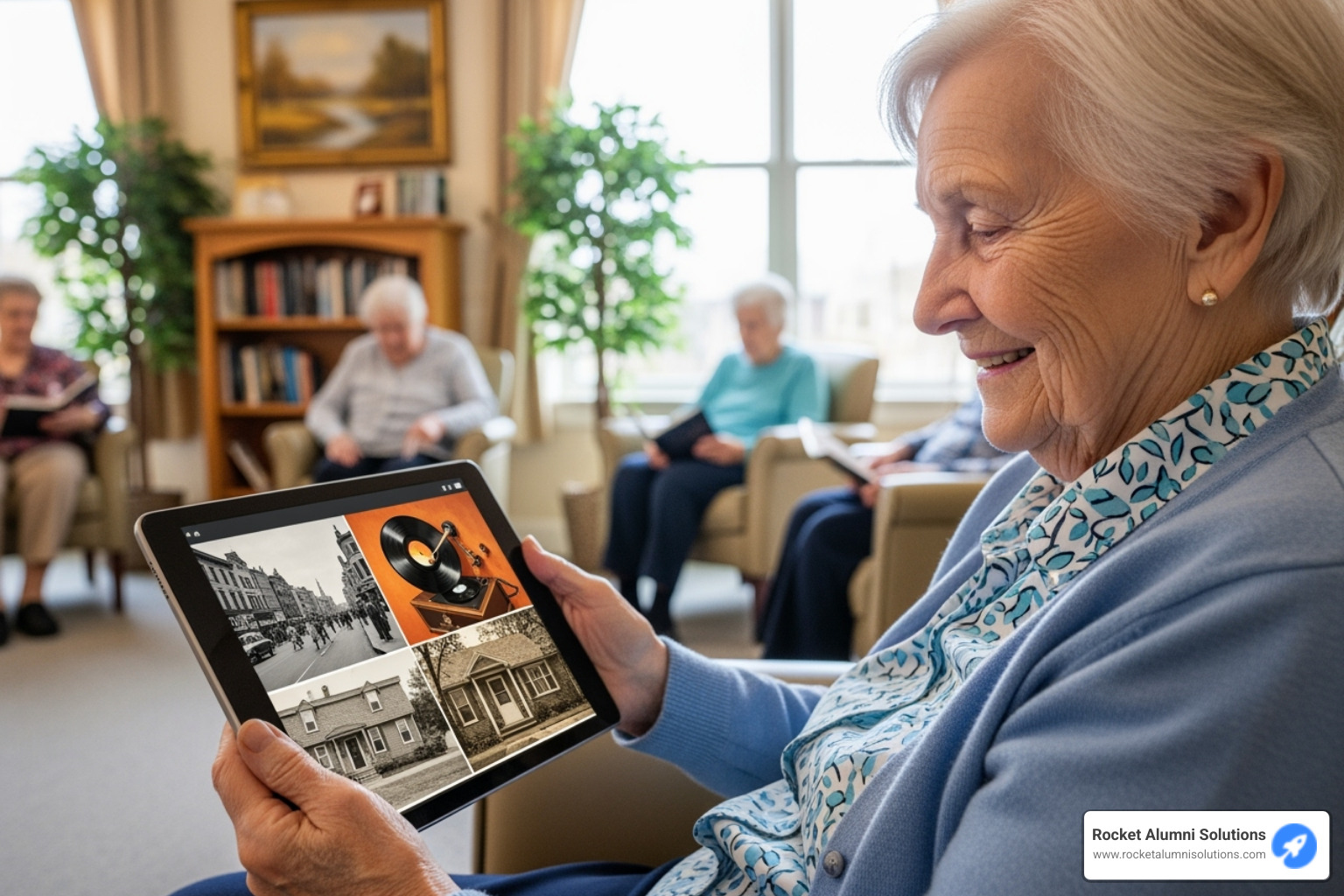
The numbers tell an incredible story. In one skilled nursing center, group activity attendance jumped from a modest 10-12 people to an impressive 30-35 people after introducing touchscreen technology. That's not just a statistic—it represents more laughter echoing through hallways, more hands reaching out to participate, and a stronger sense of community.
Our experience with Community Engagement Touchscreen Solutions has taught us that the right technology can transform how people connect and engage, whether in schools, healthcare facilities, or community centers.
Enhancing Cognitive Function and Mental Agility
When we talk about cognitive health in senior care, nursing home touchscreen applications offer something truly special. They provide gentle, engaging ways to keep minds active and alert, especially for residents living with dementia.
Think about it: traditional brain games can feel like work, but touchscreen activities feel like play. Reminiscence therapy becomes an trip when residents can virtually visit their old neighborhoods or flip through digital photo albums filled with familiar faces. The engagement is remarkable—one study found that participants attended 80% of digital reminiscence therapy sessions, with no negative side effects reported.
Memory games and puzzles transform into colorful, interactive experiences. Digital jigsaw puzzles let residents work at their own pace, while trivia games about the "good old days" spark animated discussions. Brain training apps disguised as fun activities help sharpen focus and problem-solving skills without feeling like exercises.
The beauty of our Digital Memory Vault concept lies in how it preserves and celebrates personal histories, creating touchpoints that connect residents to their most treasured memories.
Fostering Social Connections and Reducing Isolation
Loneliness can be the silent epidemic in senior living communities, but nursing home touchscreen technology offers powerful antidotes. These devices become bridges—connecting residents to each other, to their families, and to the wider world.
Group games on large interactive tables create natural gathering spots. Suddenly, residents who might normally sit alone are collaborating on digital puzzles or competing in friendly trivia matches. The screens become conversation starters, with one person's virtual tour of Paris inspiring another to share their own travel memories.
Video calls with family transform from complicated technical challenges into simple, one-touch connections. Grandchildren can share their latest artwork, adult children can check in during lunch breaks, and families separated by distance can maintain meaningful relationships.
Shared virtual experiences open up endless possibilities. Residents can "visit" their childhood homes through Google Earth, explore famous museums together, or take virtual nature walks through national parks. These shared trips create bonds and give residents common experiences to discuss long after the screen is turned off.
Our Touchscreen Kiosk for Virtual Tours demonstrates how technology can bring the world to people, creating opportunities for exploration and connection that transcend physical limitations.
Supporting Physical Activity and Rehabilitation
Physical wellness doesn't stop being important as we age—it just needs to be approached differently. Nursing home touchscreen technology makes movement engaging and accessible, turning exercise from a chore into an enjoyable activity.
Guided exercises come alive on screen with cheerful instructors leading chair yoga sessions, gentle tai chi movements, or seated dance routines. Residents can follow along at their own pace, and the visual cues help them stay engaged throughout the session.
Dexterity games cleverly disguise physical therapy as entertainment. Touching, swiping, and tapping motions improve fine motor skills and hand-eye coordination while residents play games or create digital art. The interactive nature makes these activities feel less like rehabilitation and more like recreation.
Virtual bike rides offer trip for residents with limited mobility. They can pedal through scenic countryside, busy city streets, or peaceful beach paths, getting light physical activity while experiencing the joy of exploration.
Advanced features like palm rejection technology ensure that residents can comfortably rest their hands on the screen without interfering with the activity, while specialized tools make interaction possible even for those with dexterity challenges. These thoughtful design elements ensure that physical limitations don't become barriers to engagement and enjoyment.
Content and Applications: What Powers the Experience?
The hardware is just the beginning - it's the rich content and thoughtful applications that transform a nursing home touchscreen into a gateway for engagement and joy. Think of it like a television: the screen itself is useful, but it's the programming that keeps people coming back for more.
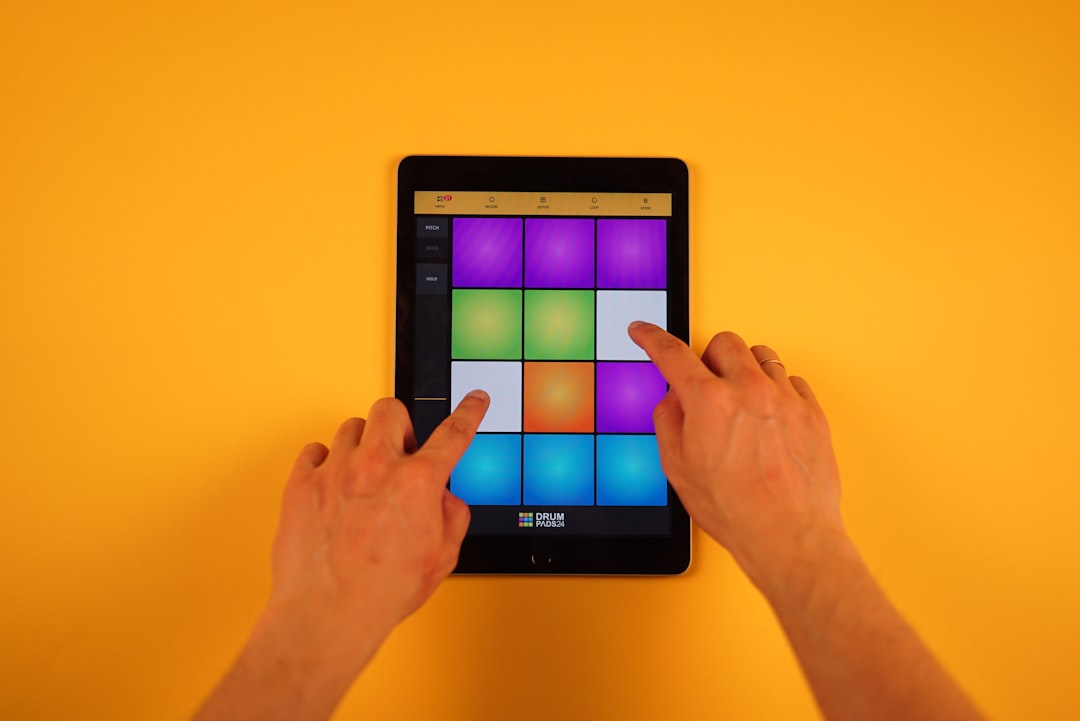
Most touchscreen systems come with pre-loaded content libraries that are constantly growing. Some platforms add over 5,000 new pieces of content monthly, ensuring residents always have fresh activities to explore. This constant stream of new material keeps the experience exciting and prevents boredom from setting in.
Behind the scenes, a robust Content Management System (CMS) makes it easy for staff to update displays, add new activities, and customize what residents see. Our experience with Touchscreen Software has taught us that the best systems are intuitive for both residents and the staff who manage them.
Popular Application Categories for Seniors
The variety of applications available on nursing home touchscreen devices is impressive, covering virtually every interest and hobby you can imagine. Games form the backbone of most systems, featuring everything from familiar card games like solitaire and blackjack to digital bingo sessions that can bring entire rooms together. Trivia contests tap into decades of accumulated knowledge, while puzzle games provide gentle mental exercise.
Communication tools have become especially valuable, offering simple email interfaces and video calling platforms that help residents stay connected with family and friends. Many systems make these connections as easy as touching a photo of a loved one.
Entertainment options transport residents to different times and places through classic films, documentaries, and music libraries filled with songs from their youth. Some systems even include customizable "jukeboxes" where residents can create their own playlists of favorite tunes.
Creative tools open up artistic expression through digital painting apps, storytelling platforms, and even virtual musical instruments. It's remarkable to watch someone who hasn't played piano in years light up when they find a digital keyboard.
Wellness and education applications offer guided meditation, virtual travel experiences through platforms like Google Earth, current news updates, and educational content on topics that spark curiosity. Our Interactive Educational Displays demonstrate how learning can remain engaging and accessible throughout life.
Customization: Creating a Personal Nursing Home Touchscreen Experience
What truly transforms a nursing home touchscreen from a generic device into something special is personalization. When residents can save their favorite games, access their own photo albums, and connect with their specific interests, the technology becomes an extension of who they are.
Personalized resident profiles allow each person to have their own digital space, complete with preferred activities, communication contacts, and customized settings. This means Mrs. Johnson can have her crossword puzzles and classical music ready to go, while Mr. Garcia can access his baseball trivia and jazz collection.
Family photos and videos breathe life into the experience. Uploading personal images creates interactive digital scrapbooks that residents can easily browse and share with visitors. These personal touches often become conversation starters that bridge generations.
Custom playlists and themed content keep the experience fresh and relevant. During holidays, content can be adapted to match the season, while individual music preferences ensure each resident hears songs that resonate with their personal history.
Cognitive-level customization is particularly important for residents with dementia. Content can be carefully selected to provide appropriate stimulation without causing confusion or frustration. This thoughtful approach ensures everyone can participate meaningfully.
This level of personalization creates experiences that feel authentic and meaningful. Just as our Digital Legacy Wall and Interactive Tribute Tech solutions help communities celebrate individual stories, customized touchscreen content helps residents maintain their sense of identity and connection to what matters most to them.
Streamlining Operations: How Touchscreens Empower Nursing Home Staff
Beyond resident engagement, nursing home touchscreen technology transforms how nursing home staff work every day. These interactive displays don't just make jobs easier - they fundamentally change how care teams operate, communicate, and deliver quality care. When staff can work more efficiently, everyone wins.
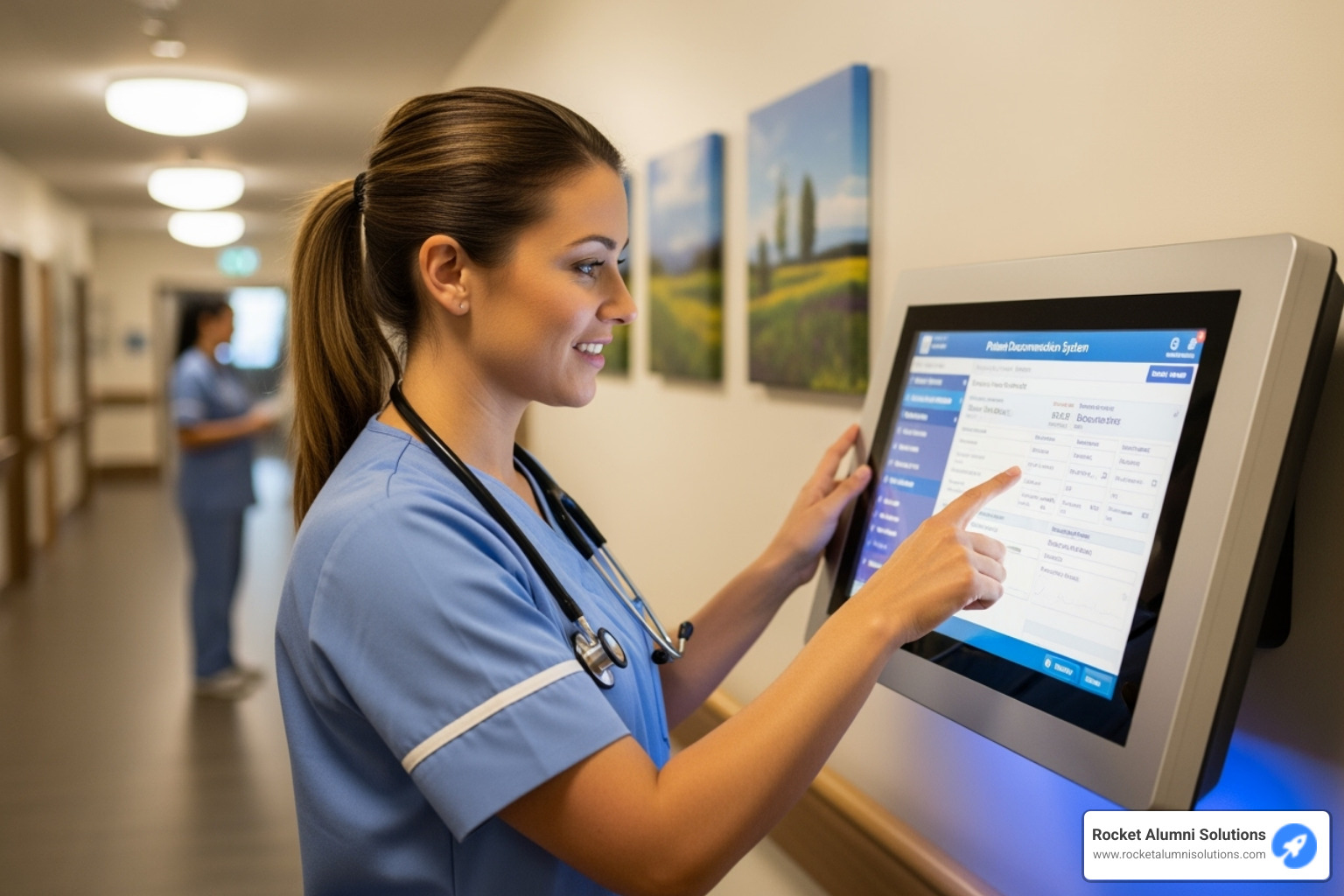
The numbers tell a compelling story. Advanced touchscreen systems can handle over 20 million check-ins per year, eliminating countless hours of manual paperwork and administrative tasks. This isn't just about efficiency - it's about giving caregivers more time to focus on what they do best: caring for residents.
As someone who's worked extensively with digital solutions across various industries, I've seen how the right technology can transform workplace culture. Our Digital Employee Recognition Display solutions have shown us how digital tools can boost staff morale while streamlining operations.
Visitor and Staff Management
The front desk used to be a bottleneck in most nursing homes. Now, nursing home touchscreen kiosks handle many of these tasks automatically, creating a smoother experience for everyone who enters the facility.
Automated health screening has become especially important in recent years. Touchscreen kiosks can conduct temperature checks, ask customizable health questionnaires, and even track vaccination status. This protects residents while reducing the workload on front desk staff. For facilities looking to implement these systems, our health screening solutions provide comprehensive guidance.
Visitor check-in and check-out processes become seamless with touchscreen technology. Families can sign in independently, receive visitor badges, and even complete feedback surveys when they leave. Some systems automatically request online reviews, helping facilities build their reputation while gathering valuable feedback.
Staff time tracking gets simplified too. Instead of punch cards or manual logs, staff can clock in and out using touchscreen terminals. This creates accurate records, reduces payroll errors, and eliminates the need for physical timesheets.
Digital announcements keep everyone informed without constant interruptions. Staff can quickly post important updates, schedule changes, or safety alerts on displays throughout the facility. This ensures critical information reaches the right people at the right time.
Care and Activity Planning
When it comes to direct resident care, touchscreen technology becomes an invaluable partner for nursing staff. Digital care documentation allows caregivers to update resident records in real-time, right from the bedside or common areas. No more carrying clipboards or trying to remember details to write down later.
Staff can quickly access resident information including medical needs, dietary restrictions, and personal preferences. This immediate access to comprehensive profiles helps ensure personalized care and reduces the risk of errors.
Activity scheduling becomes much more manageable with interactive digital calendars. Activity directors can plan events, track attendance, and communicate schedules to both residents and families. Our Interactive Digital Calendar Solutions demonstrate how these systems can transform program management.
Perhaps most importantly, touchscreen systems serve as a resource for planning group sessions. With thousands of pre-loaded activities, games, and content options, staff have endless inspiration for engaging programming. This variety keeps activities fresh and helps staff find new ways to connect with residents.
The result? Staff spend less time on paperwork and more time building meaningful relationships with the people they serve. That's the kind of technological advancement that truly makes a difference in senior care.
Practical Guide to Implementing and Maintaining Touchscreen Technology
Getting started with nursing home touchscreen technology doesn't have to feel overwhelming. Like any worthwhile investment, it simply requires thoughtful planning and a step-by-step approach. Having worked with digital display solutions across various sectors, including assisted living facilities, I've learned that successful implementation comes down to careful preparation and realistic expectations. Our Assisted Living Touchscreen expertise has shown us exactly what makes these projects succeed.
The implementation journey follows a logical progression. First comes assessment - taking an honest look at your current needs, resident demographics, staff capabilities, and available space. Next is budgeting, where you'll determine your financial resources for hardware, software, installation, and those often-forgotten ongoing costs.
Vendor selection deserves special attention. You'll want to research providers carefully, focusing on reputation, product features, support quality, and customization options. The installation phase involves planning for physical setup, network integration, and initial content loading.
Training is where the magic happens - providing comprehensive training for staff while gradually introducing residents to their new digital companions. Finally, maintenance establishes protocols for hygiene, troubleshooting, updates, and technical support.
Think of it like introducing a new friend to your community. You wouldn't just drop them off and hope for the best - you'd make proper introductions, show them around, and help everyone get comfortable together.
Designing for Seniors: Essential Accessibility Features for a Nursing Home Touchscreen
The most sophisticated nursing home touchscreen system in the world won't help anyone if residents can't use it comfortably. Accessibility isn't just a nice-to-have feature - it's the foundation of successful senior-focused technology.
Large icons and text ensure readability for those with visual impairments, while high-contrast displays reduce eye strain and improve visibility. The interface should feature simple navigation with intuitive, single-touch actions that avoid complex menus or confusing gestures.
Physical comfort matters tremendously. Adjustable height and angles allow comfortable use whether someone is in a wheelchair, bed, or standing position. Palm rejection technology is particularly helpful, letting users lean on the screen without triggering unintended responses.
Durable, easy-to-clean surfaces are non-negotiable in healthcare settings. Medical-grade screens with toughened, water-resistant glass can withstand daily use and harsh cleaning products. Offline functionality with pre-loaded content ensures the system works even when internet connections are spotty.
Some systems include innovative features like Tool Explorer, which uses easy-to-grip physical stamps for interaction. This helps residents with dexterity challenges or language barriers participate fully. Content sharing to personal devices also supports residents with mobility limitations.
From Planning to Practice: Key Implementation Considerations
Once you've chosen your nursing home touchscreen solution, several practical considerations will determine your long-term success. Cost and ROI extends far beyond the initial purchase price. While the upfront investment varies widely, consider the return through increased resident satisfaction, improved well-being, reduced staff workload, and improved facility reputation.
Hardware durability becomes crucial in daily use environments. Medical-grade devices that can withstand regular cleaning and constant interaction are worth the investment. Staff and resident training requires patience and persistence. Comprehensive staff training ensures they can effectively use the system and guide residents confidently.
For residents, gradual introduction works best. Start with simple, familiar activities and build complexity over time. Hygiene protocols and sanitization need clear, consistent procedures to prevent germ spread while maintaining equipment functionality.
Technical support and warranties provide peace of mind. Ensure your vendor offers reliable support, comprehensive warranties, and clear return and repair policies. You can often check warranty status and review return policies before making decisions.
Data privacy and security cannot be overlooked. Systems handling resident data - health records, personal photos, communication logs - require robust security measures and compliance with privacy regulations. This protects both residents and your facility from potential breaches.
Successful implementation isn't about having the fanciest technology. It's about choosing solutions that genuinely improve daily life for residents and staff while fitting seamlessly into your care environment.
Frequently Asked Questions about Nursing Home Touchscreens
Are touchscreens difficult for seniors with dementia to use?
This is one of the most common concerns we hear, and it's completely understandable. The truth is, nursing home touchscreen technology can be incredibly beneficial for seniors with dementia when it's designed and introduced thoughtfully.
The secret lies in intuitive design and simple interfaces. The best systems use large, high-contrast buttons with minimal text to reduce confusion. Instead of complex menus, they focus on familiar content like music from their era, old photographs, or simple sensory apps that respond to touch with pleasing sounds or colors.
Gradual introduction is key to success. Start with just one easy-to-use app - maybe a photo slideshow or a simple music player. With patient staff guidance and encouragement, most residents can learn to enjoy these tools at their own pace.
The benefits of cognitive stimulation often far outweigh any initial learning curve. We've seen residents who were initially hesitant become some of the most enthusiastic users once they find content that resonates with them.
What is the typical cost of a touchscreen system?
The cost of a nursing home touchscreen system varies widely, and honestly, that's because every facility has different needs and goals. Think of it like buying a car - there are budget-friendly options and luxury models, each serving different purposes.
Hardware choices make a big difference in pricing. A personal tablet for individual use will cost significantly less than a large interactive table that serves an entire common room. Comprehensive kiosk systems with multiple features fall somewhere in between.
Software models also vary. Some systems require monthly or annual subscription fees, while others offer one-time purchase options. The level of customization, technical support, and training you need will also affect the total investment.
Rather than focusing solely on upfront costs, consider the long-term return on investment. Increased resident satisfaction, improved staff efficiency, and improved facility reputation all contribute to value. Many facilities also find opportunities for grants or funding specifically designated for technology in elder care.
We always recommend getting quotes from multiple providers and asking about total cost of ownership, including maintenance, updates, and support.
How do we ensure the content is appropriate and engaging for our residents?
Creating engaging, appropriate content is where the magic really happens with nursing home touchscreen technology. The key is remembering that every resident is unique, with their own interests, background, and cognitive abilities.
Look for customizable platforms that let you tailor experiences to individual preferences. The best systems allow you to create personalized resident profiles, adjusting content based on interests, cognitive levels, and cultural backgrounds.
Involve residents and families in content selection whenever possible. They know best what will spark joy and engagement. Ask about favorite songs, hobbies, places they've lived, or activities they enjoyed. This personal touch makes all the difference.
Regularly updating content keeps the experience fresh and prevents boredom. Systems with diverse libraries give you more options, and features that allow uploading family photos and videos create deeply personal experiences that residents treasure.
Consider using systems that support community-specific content. Our experience creating custom digital displays, such as a Digital Donor Wall, has shown us how powerful personalized digital experiences can be when they reflect the unique character of a community.
What engages one resident might not work for another. The flexibility to adapt and customize ensures everyone can find something meaningful in the technology.
Conclusion
Nursing Home Touchscreen technology represents a genuine revolution in how we care for our seniors. It's not just about keeping up with the latest gadgets - it's about fundamentally improving lives and creating communities where residents truly thrive.
Throughout this guide, we've finded the incredible variety of touchscreen solutions available today. From large interactive tables that bring residents together for group activities to personal tablets that offer private entertainment and family connections, these tools are reshaping the senior care landscape. We've seen how wall-mounted displays and kiosks streamline daily operations while projection-based systems create entirely new ways to engage.
The benefits speak for themselves. When residents can participate in cognitive stimulation through memory games and reminiscence therapy, stay connected with loved ones through video calls, and even engage in gentle physical activities through guided exercises, their quality of life improves dramatically. Striking statistic - group activity attendance jumping from 10-12 people to 30-35 people? That's not just numbers; that's more laughter, more friendships, and more joy in daily life.
For nursing home staff, these systems are game-changers. Automated health screening, digital documentation, and streamlined visitor management free up precious time that can be redirected to direct patient care. When technology handles the routine tasks, caregivers can focus on what they do best - caring for people.
The implementation journey requires thoughtful planning, from accessibility features like large icons and high-contrast displays to hygiene protocols and staff training. But facilities that invest in these systems consistently see returns in resident satisfaction, operational efficiency, and overall community well-being.
At Rocket Alumni Solutions, we understand the power of technology to create meaningful connections. Our experience building digital recognition and display solutions has taught us that the best technology doesn't just inform - it inspires, celebrates, and brings people together. Whether through interactive tribute walls that honor life stories or comprehensive engagement solutions that strengthen communities, we're passionate about using technology to make a difference.
The future of senior care is here, and it's more connected, engaging, and hopeful than ever before. We invite you to explore how our Achievement Recognition & Healthcare Engagement solutions can transform your facility. Find our Interactive Touchscreen Software Solutions and see how we can help you create a more vibrant, connected community for the seniors in your care.



















































































































